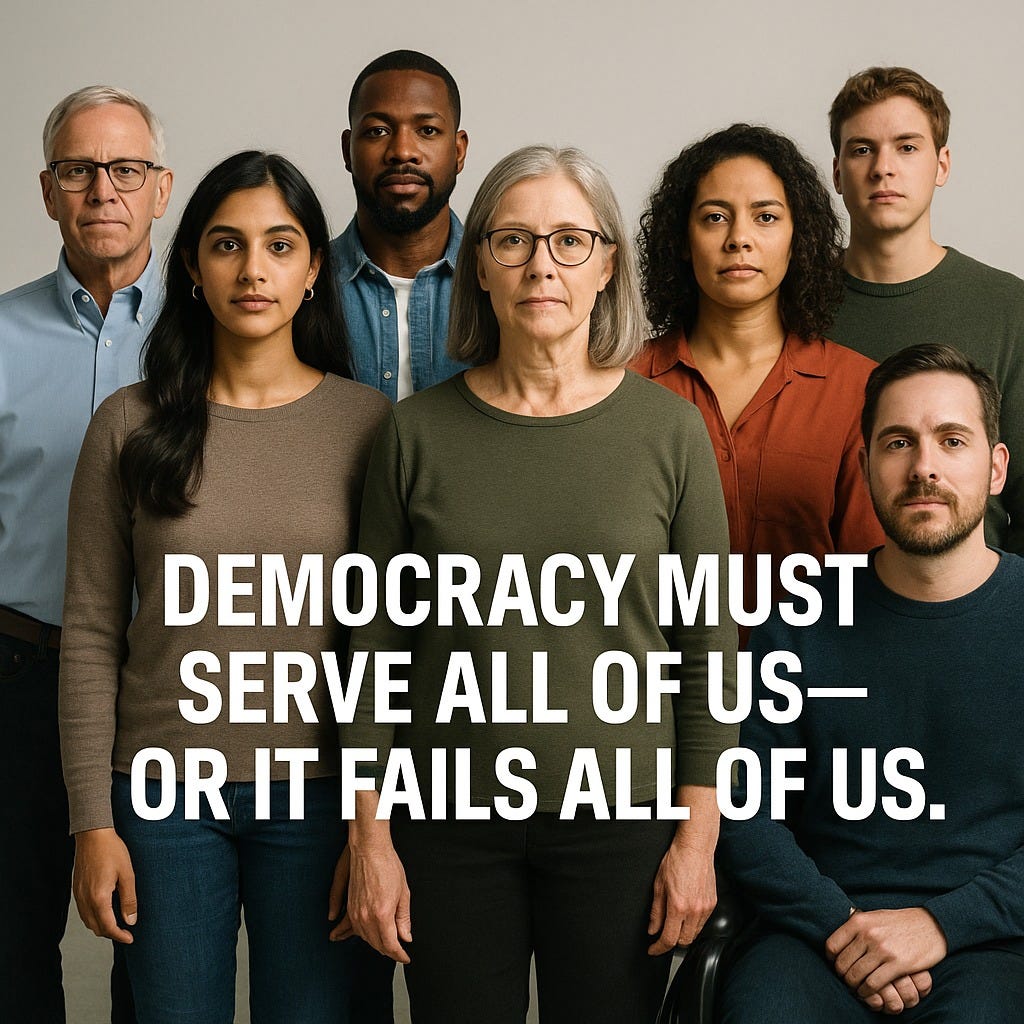✍️ The Danger of the Middle Ground
The real divide isn’t left vs. right. It’s inclusion vs. exclusion.
Amid signs of internal fractures in the Republican/MAGA Party—and renewed calls from pundits for Democrats to “meet in the middle”—there’s pressure once again to chase consensus by softening our stance.
But that instinct can be dangerous. The real path forward isn’t watering down core values. It’s standing strong for policies that meet people’s needs—economic, personal, and community-wide—through bold, inclusive leadership.
And here’s what moderation is being used to justify right now:
Trump’s so-called “moderate” immigration reforms that gut asylum protections while claiming to fix a broken system.
Supreme Court rulings that roll back decades of rights—praised by conservative voices as efforts to “restore balance.”
Editorials from conservative and centrist voices call for a “reasonable middle ground” on abortion or trans rights—by limiting them in the name of compromise.
Now more than ever, it’s worth asking what “moderate” really means—and whom it actually serves.
Some folks say the middle lane is the safest place to drive. But in politics, that “middle” can be a dangerous illusion.
We hear calls for unity and compromise, but what happens when that means:
Protecting civil rights, but only for some people?
Mitigating climate change, but only for certain regions?
Promoting national security, but neglecting diplomacy, peace-building, or arms control?
Funding quality education, but not for all kids?
Defending free speech, but only for a few viewpoints?
What kind of democracy is that?
We’re told this centrism promotes healing. But too often, what’s called “moderate” is really selective justice—justice filtered through wealth, privilege, and tradition. It helps people already in power, leaving everyone else waiting—or shut out entirely.
Moderate policies might sound reasonable. But:
A moderate tax stance might still protect billionaires.
A moderate health care plan might still leave millions uninsured.
A moderate education plan might still ignore struggling schools.
And some issues simply don’t lend themselves to easy compromise:
What’s the middle ground on bodily autonomy or reproductive rights?
On mass shootings and assault weapons?
On affirming the humanity of LGBTQ+ people?
Trying to split the difference on these isn’t pragmatic—it’s evasive. Comfort for whom?
This is where we must return to the core purpose of our democracy.
The U.S. Constitution doesn’t call on us to protect “some” people. Its preamble says: “establish Justice, insure domestic Tranquility, provide for the common defense, promote the general Welfare, and secure the Blessings of Liberty to ourselves and our Posterity.”
Not for the few. Not for the rich. Not for the agreeable. For everyone.
So maybe the real divide today isn’t left vs. right.
It’s inclusion vs. exclusion.
Do we want a society that serves all of us—or just some of us?
👉 If you consider yourself a moderate, ask yourself:
Moderate compared to what? And are you OK with selective justice in exchange for political comfort?
If moderation is your goal, how do you ensure it’s not just compromise for the privileged but fairness for the many? How do you propose something that’s truly moderate but still principled—and persuades people across the political spectrum to support it?
These are not easy questions. But in a democracy, they’re essential ones.
This isn’t a call for extremism. It’s a call for principle.
Democracy isn’t about standing still in the middle of the road. It’s about deciding what kind of society we want—and who’s included in it.
Other Questions Worth Asking:
What does fairness in democracy mean to you—not just in principle but also in practice?
What’s worth compromising—and what’s not?
If we call something “moderate,” how do we ensure it’s not just a label but also a step toward real, inclusive solutions that people across the spectrum can live with?
🗳️ Looking Ahead to 2026
As we move toward the midterm elections, let’s not mistake cautious rhetoric for courage. The real “middle” most Americans want isn’t between extremes. It’s between being ignored and being heard—between being left out and finally being included.
Voter indecision is real. So is disinformation. So is the temptation to embrace “neutrality” or “both sides” framing when the truth—and people’s rights—are under attack.
But moderation that comforts the privileged while abandoning principle isn’t compromise. It’s surrender.
This moment calls for clarity, courage, and conviction. Not to inflame but to inform. Not to divide but to decide.
Let’s make sure we’re choosing a path that includes everyone—not just those already safe in the center or the right.



